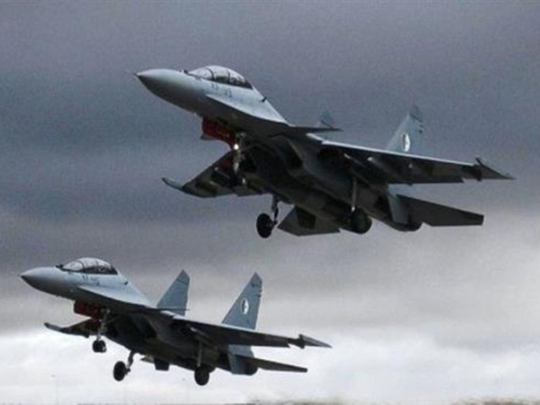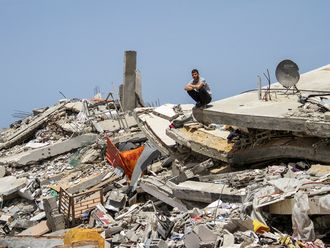
Washington: Earlier this week analysts found that RT, a government-funded Russian media company, edited out footage that initially showed Russian jets in Syria armed with incendiary munitions. The original clip was restored after RT said it had deleted the footage out of concerns for the pilot’s safety.
The use of incendiary weapons in Syria is nothing new - they’ve been dropped by Syrian government forces, albeit intermittently, since 2012. However, the munitions’ recent appearance, namely a pair of RBK-500 ZAB-2.5SM bombs strapped to the bottom of a Russian Su-34, comes among increasing reports of their use, namely around the besieged city of Aleppo.
Russia is party to a United Nations protocol that bans the use of air-dropped incendiary munitions onto areas that have concentrations of civilians; the Syrian government, however, is not.
According to N.R. Jenzen-Jones, director of the company Armament Research Services, the last time incendiary munitions were used in large concentrations, of the likes seen since the beginning of June, was in early 2013, indicating that the Syrian government has either been resupplied or is relying on the Russians to drop their own. Comparatively, however, incendiary weapons are trivial compared to the casualties caused by other weapons such as barrel bombs, improvised explosive devices and rifle fire.
Recent clips posted to YouTube show a number of strikes in the suburbs of Aleppo, where Syrian government forces have fought for months in an attempt to take the city from opposition forces. The footage, taken mostly at night, shows streaks of what looks like fireworks blossoming downward and erupting into flames on the ground. According to Mary Wareham, the arms advocacy director at Human Rights Watch, the type of incendiary munitions seen most frequently in Syria appear to be thermite-based weapons, and are often misidentified as napalm and white phosphorus. Similar in purpose, napalm and white phosphorus have checkered pasts that began with their use by the United States during the Vietnam War.
Designed to be hard to extinguish, incendiary weapons such as napalm, thermite and white phosphorus have often been used as defoliants, meant to burn away cover for those hiding in thick brush. In urban areas, however, the effect is similar, razing buildings to the ground and immolating those caught in their blast radius. Some types of thermite munitions identified in Syria contain a high explosive bursting charge, making just extinguishing them dangerous.
According to Wareham, the prevalence of both air-dropped cluster and incendiary munitions in past weeks and their possible use in a recent hospital bombing in Aleppo has been troubling, and has since prompted the Human Rights Watch to begin an in-depth look at where the weapons are being used and if incendiary munitions are being dropped on civilian populations.
“The footage that you see. . ..does show what looks like the remnants of incendiary weapons in what looks like infrastructure and next to vehicles and that would indicate that it’s a civilian area,” Wareham said. “We’re still doing our research, so we’re not ready to make that call just yet but that’s what it’s look like.”
While most incendiary bombs are not considered cluster munitions under international law - as they do not contain explosives - some contain smaller charges that explode on impact, known as submunitions. These munitions’ characteristics are not always well understood, even by experts in the field, Jenzen-Jones said. According to Jenzen-Jones, his group has identified 17 different types of submunitions, often varying between golf ball- and watermelon-sized, in Syria.
Dozens of countries are signatories to a UN charter banning cluster munitions, though Russia, Syria and the United States are not. During the 2011 UN convention on conventional weapons in Geneva, Russia indicated that cluster munitions have “a very substantive role” in its collective defense. The last time the United States used cluster munitions in large quantities was during the 2003 Iraq invasion, though Saudi Arabia has used US-provided cluster bombs during its recent intervention in Yemen. Last week, images posted by the Syrian Observatory for Human Rights, indicated that Russian jets cluster-bombed US-backed Syrian forces near the Jordanian border, prompting an outcry from US officials.
Russia has denied using cluster bombs in Syria, saying in a statement posted to the Ministry of Defense’s website that “Russian aviation does not use them” and that “there are no such munitions at the Russian air base in Syria.”
Russia had not made similar claims about incendiary weapons, and last year, after human rights groups expressed concern regarding their use, Foreign Minister Sergei Lavrov, in a letter to Human Rights Watch, acknowledged their “significant humanitarian damage,” which he attributed to their “improper use.”
Now in its fifth year, the war in Syria has claimed the lives of more than 250,000 people and displaced millions.












